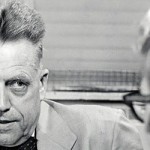Widely recognized as Indiana University’s most influential president, Herman B Wells had much to do with the institution’s prestige.
Upon his inauguration in 1938, Wells leapt to the task of recruiting dynamic and innovative professors, reportedly traveling over 33,000 miles for the cause in his first year alone. Wells’ recruits ranged beyond well-established names to those who were unpopular or just emerging.
Biologist Tracy Morton Sonneborn had recently earned his graduate degree from Johns Hopkins University when Wells offered him a faculty position in 1939. Sonneborn’s insatiable curiosity for the workings of the cell has been charted over a number of articles that have become integral to the scientific canon.
Wells also recognized the potential of Hermann Muller, who had been investigated for purported Communist leanings. During Muller’s two decades at IU, he won the Nobel Prize for research regarding genetic mutations due to exposure to radiation—critically significant in the wake of the bombings of Nagasaki and Hiroshima.
Wells’ support of zoologist Alfred Kinsey is perhaps best known. Widely censured in the 1950s for his work on human sexuality, the founder of the internationally esteemed Kinsey Institute found a great ally in Wells, who was convinced that a university “be a free agent, … and the only way to keep it free is to be willing to fight when necessary…”






















